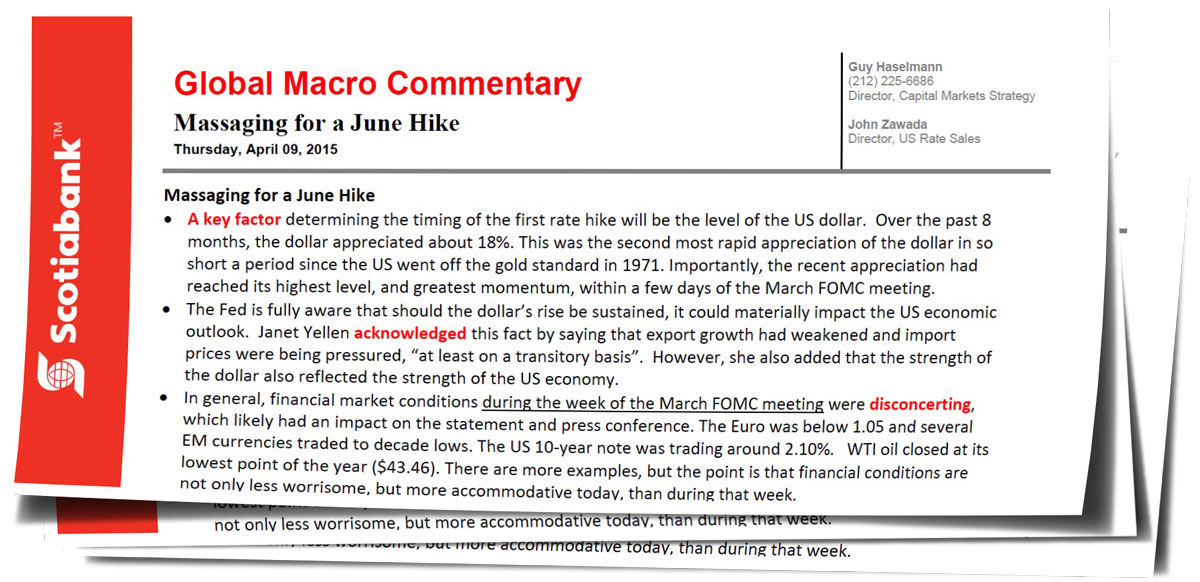Massaging for a June Hike
by Guy Haselmann, Director, Capital Markets Strategy, Scotiabank GBM
· A key factor determining the timing of the first rate hike will be the level of the US dollar. Over the past 8 months, the dollar appreciated about 18%. This was the second most rapid appreciation of the dollar in so short a period since the US went off the gold standard in 1971. Importantly, the recent appreciation had reached its highest level, and greatest momentum, within a few days of the March FOMC meeting.
· The Fed is fully aware that should the dollar’s rise be sustained, it could materially impact the US economic outlook. Janet Yellen acknowledged this fact by saying that export growth had weakened and import prices were being pressured, “at least on a transitory basis”. However, she also added that the strength of the dollar also reflected the strength of the US economy.
· In general, financial market conditions during the week of the March FOMC meeting were disconcerting, which likely had an impact on the statement and press conference. The Euro was below 1.05 and several EM currencies traded to decade lows. The US 10-year note was trading around 2.10%. WTI oil closed at its lowest point of the year ($43.46). There are more examples, but the point is that financial conditions are not only less worrisome, but more accommodative today, than during that week.
· Since March 18th, , for example, the dollar is 2% lower, the S&P is higher, Treasury yields are lower, and oil is 18% higher (taking downward pressure off of inflation indicators). If the Fed based its decision solely on those market factors, the probability of a June hike should be higher today (not lower) than it was on the day of the March meeting.
· It might sound strange, but the Fed is probably thrilled by the fact that the probability of a June hike has fallen (to around 12% today). On numerous occasions, the Fed has stated its desire to move off of the zero lower bound (ZLB). If the markets had become truly convinced of a June hike, then Treasury rates and the dollar might have risen further, while equities might have moved lower. Those conditions could have made a hike in June more difficult.
o If the Fed Funds rate were 3%, hypothetically, the Fed would not mind if markets ‘did the tightening for the Fed’. However, with official rates near 0%, the Fed would prefer doing the hiking by itself.
· The FOMC probably did not want to be too hawkish at the March meeting for fear a market reaction that damaged its own position for rate ‘lift-off’. It should be remembered that markets were expecting the word ‘patient’ to be removed, thus providing a hawkish landscape that opened up the optionality for a June hike. In order to prevent tightening market conditions, owing to fully pricing-in a June hike, the FOMC had to provide some dovish offsets (see Great Aunt Addy Policy Aug. 8, 2014). It did so, and then the disappointing, but meaningless, headline employment number, furthered its cause.
· In order to proceed with a June ‘lift-off’, it would be ideal for the FOMC if stocks, bonds, the dollar, and economic data were anywhere near current levels by the time of the June meeting. Economic data is unlikely to move much in either direction by then. Most already know that Q1 was weak, and most believe that Q2 will provide some bounce-back. This scenario would work in the Fed’s favor.
· Zero rates are simply no longer needed. The Fed doesn’t need to stay ‘lower for longer’, because it has already done that. Waiting until September would mean a much greater possibility of missing their window of opportunity. Market conditions might deteriorate or geo-political tensions rise in a way that more deeply affects the US. Alternatively, market froth might grow even frothier, causing a larger market reaction than otherwise would have been the case. Lastly, it would also be prudent to hike well in advance of the $215 billion of Treasuries on the Fed’s balance sheet that matures in early 2016; which, if left un-reinvested, is a defacto-tightening.
· The Fed’s data dependency message is bewildering when looking at the economic data. Regardless of last week’s headline payroll number, employment remains more than adequate and inconsistent with a 0% policy. The unemployment rate has reached the near full-employment level of 5.5%, and will likely be even lower by June. The 4-week average for jobless claims printed today at the lowest level since April 2000 when the Fed Funds rate was 6%. As far as its inflation mandate, many FOMC members say that they believe inflation will move back to its 2% target in the medium term (2 to 3 years). And, other than during the 2008 crisis, inflation has been mostly stable for 20 years.
“It's something unpredictable, but in the end is right. I hope you had the time of your life.” – Green Day
Regards,
Guy
Guy Haselmann | Director, Capital Markets Strategy
▬▬▬▬▬▬▬▬▬▬▬▬▬▬▬▬▬▬▬▬▬▬▬▬▬▬▬
Scotiabank | Global Banking and Markets
250 Vesey Street | New York, NY 10281
T-212.225.6686 | C-917-325-5816
guy.haselmann@scotiabank.com
Scotiabank is a business name used by The Bank of Nova Scotia














